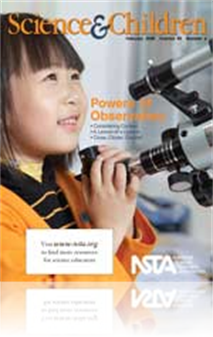All Science and Children resources
Journal Article
If life hands you lemons, make lemonade. This age-old advice is hard to argue with, but if you’re handed lemons in science class, it’s time to make observations. “A Lemon of a Lesson” provides valuable opportunities for students to hone their...
Journal Article
Every Day Science: February 2008
This monthly feature contains facts and challenges for the science explorer. ...
Journal Article
As educators, we are always deciding what experiences we want to give students in order to achieve our goals of developing science process skills. One of the best ways of teaching about observation is described here. Using a hand lens and an illumina...
Journal Article
Teaching Through Trade Books: Seeing Stars
The winter months are a great time to make observations of several familiar constellations. While there’s no scientific reason to “know” the constellations—they are simply imaginative pictures imposed on stars—studying constellations can he...
Journal Article
Properties are “hot,” not in terms of real estate but in science class. Here, the editor highlights the feature articles related to this month’s theme, Properties of Objects and Materials. With these articles as a guide, you can move students t...
Journal Article
Many teachers and students have experienced the classic pet rock experiment in conjunction with a geology unit. A teacher has students bring in a “pet” rock found outside of school, and the students run geologic tests on the rock. The tests inclu...
Journal Article
Perspectives: Explaining Science
We often think of science as exploration and experiment. However, classrooms that portray only this view of science fail to capture an essential feature of science—evidence-based explanation. When scientists encounter patterns in the world, they co...
Journal Article
Teaching Through Trade Books: A Closer Look
Give a child a hand lens or a microscope and they quickly become fascinated with the hidden worlds these tools reveal. The lessons in this month’s column provide opportunities for students to take a closer look at the properties of objects and orga...
Journal Article
Science Shorts: Stretched to the Limit
Children need to explore as many different materials as possible in order to make sense of their world. Understanding how materials behave in their natural state and under certain conditions will help them understand why objects are made of specific ...
Journal Article
Science 101: Why do we classify things in science?
Each year, in thousands of classrooms across the country, students classify animals, rocks, and other things as part of their science studies. Each year, thousands of students no doubt ask, “Why in the heck are we doing this?” Classifying things ...
Journal Article
Sponsored by NASA and the JASON Education Foundation, the remote Sensing Earth Science Teacher Education Program (RSESTeP) trains teachers to use state-of-the art remote-sensing technology with the idea that participants bring back what they learn an...



